Chinese Name: 国子监 Pronunciation: Guó Zǐ Jiàn
Building Time: 1287
Best Visiting Season: May 1st to October 31st
Recommended Time for Visit: 1-2 Hours
Occupied Area: Over 27,000 square meters
Address: No. 15 Guozijian Street, Dongcheng District, Beijing
Building Function: Guozijian is the highest educational institution and administering organ of education set in the Yuan, Ming, and Qing Dynasties.
Children under 1.2 meters (including 1.2 meters) or younger than six years old (including six years) are free of charge.
| Content | Peak Season (May-October) | Low Season (November-April) |
| Opening Hours | 8:30-18:00 | 8:30-17:00 |
| Ticket Office Opening Hours | 8:30-17:00 | 8:30-16:30 |
1. Closed on Mondays.
2. In the case of events, the announcement of opening hours will be issued in advance.
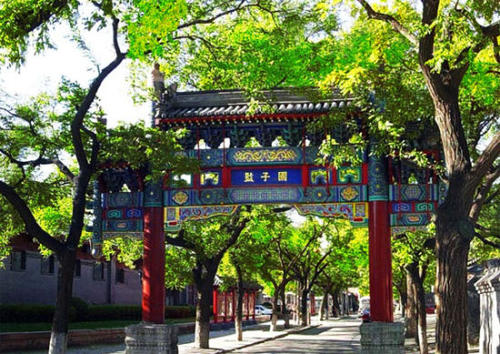
Guozijian, also called Taixue (meaning imperial college), is the highest educational institution and administering organ of education set in the Yuan (1271-1368), the Ming (1368-1644), and the Qing (1636-1912) Dynasties. It is the highest ancient college preserved more than 700 years in complete in China and the only ancient central public college construction. Guozijian is famous for its long history, unique architectural style, and profound cultural connotation.
The overall construction of Guozijian faces to the south, covering an area of about 27,000 square meters. It is composed of three rows of courtyards. Along its central axis, there are the Jixian Gate (the first gate), the Taixue Gate (the second gate), the Glazed Memorial Arch, the Biyong Hall, the Yilun Hall, and the Jingyi Hall.
There are well pavilions on the east and west of the Jixian Gate (Jixian means gathering the talents and sages of the whole country). The Bell Pavilion is on the left of the Taixue Gate, and the Drum Pavilion on its right. On the north of the gate is the Glazed Memorial Arch, covered with yellow encaustic tiles. Walking through the Glazed Memorial Arch, you will see the main body of the Guozijian—the Biyong Hall.
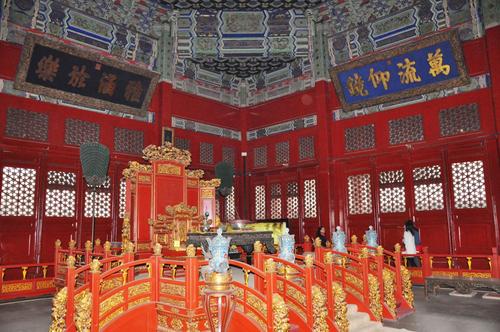
Why did Chinese emperors set up Guozijian? Emperors hoped to attract and cultivate talents to govern the country, and they had established the imperial examination system—selecting officials by public exams. Guozijian is the imperial college to cultivate students to attend imperial exams.
Students who studied in Guozijian in old times were “jian sheng” (the students of Guozijian). They were mainly two classes for their social status. Some students were from a family with his family members being officials. Others came from ordinary families.
Guozijian features in its teachers and the teaching system. The teachers were imperial officials and appointed by the Ministry of Official Personnel Affairs. Students would study six curriculums and get relative scores to graduate, and they may have the internship chance in various departments of the government.
Guozijian, in a word, resulting from the imperial examination system, has witnessed the birth, development, and death of it. The historical value and educational spirit of Guozijian are a cultural treasure not only to China but also to the world.
Guozijian was built in 1287 during the Yuan Dynasty, being repaired and expanded to a large extent during the Yongle (1403-1424) period and the Zhengtong period (1436-1449) of the Ming Dynasty. With the Biyong Hall, built as imperial buildings in 1783 (Qing Dynasty), Guozijian has formed its current construction.
In 1961, Guozijian was listed as one of the first batches of important heritage site under state protection by the State Council.
In 2006, Guozijian, together with the Confucius Temple, formed the Beijing Confucius and the Imperial College Museum.
In 2008, the Beijing Confucius and the Imperial College officially opened.
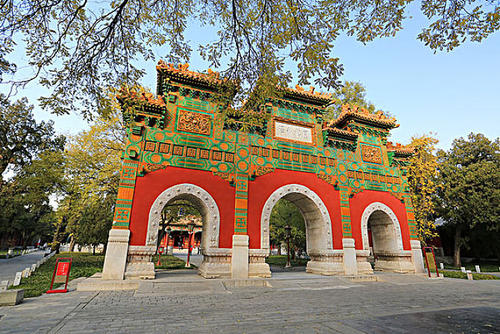
Walking into the Taixue Gate, you will see the Glazed Memorial Arch. It has three arches, four pillars, and seven hip roofs. Many ancient buildings have memorial arches in Beijing. The Glazed Memorial Arch in Guozijian, however, is still worth visiting for its magnificent outlook and status.
The first feature is that the Glazed Memorial Arch lies in front of the Biyong Hall where the emperor would give lectures, so it somewhat looks like the front gate of the Biyong Hall. The roofs are covered with yellow encaustic tiles, different from traditional memorial arches which were mostly built in temples, covered in green encaustic tiles because only emperors could have the power to use the color of yellow.
The second is that the Glazed Memorial Arch was set up for education, not for religion, without any religious decorations.
Above the middle gate, two horizontal inscribed boards with words written by Emperor Qianlong (1736-1796), are on both sides of the middle gate. They are related to education and teaching.
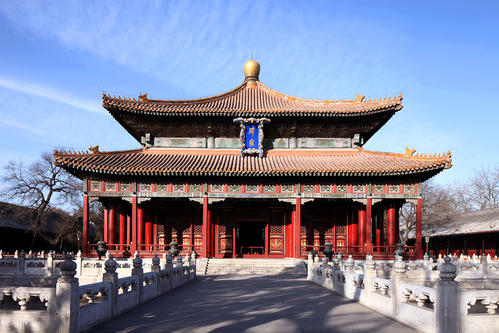
The Biyong Hall, built between 1783 and 1785, is the only preserved ancient “school” exclusively for Emperor in China. It locates in the center of Guozijian. The Biyong Hall is in the shape of a square, 17.7 meters long and wide. Its double-eaves pyramidal roof is covered in yellow encaustic tiles.
The surrounding of the Biyong Hall is winding corridors and a pond. White marble guard bars encircle the pond, and four walls of the pond are mounted faucets. The water is from the wells in the west and east of the courtyard. Pavilions built above the wells, are called “Well Pavilion”.
Four stone bridges, over the pond, lead to the four doors of the Biyong Hall. This kind of structure is in line with the regulation of school in the Zhou Dynasty (1046 BC-256 BC)—the main hall of the school shall be accompanied by water. The square hall and round pond are the symbols of round sky and square earth, and the flowing water means spreading education.
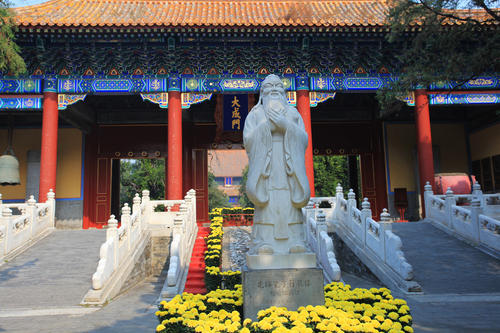
There is a story about a pagoda tree in Guozijian. The pagoda tree was planted in the Yuan Dynasty by the first principal Xu Heng. In the late Ming Dynasty, the tree died, but when it came to the early summer of 1751 (Qing Dynasty), new branches grew from the trunk.
Because the pagoda tree was revived at the time of the sixtieth birthday of Ci’ning(Emperor Qianlong’s mother), as a good omen, it was named Propitious Pagoda Tree. Emperor Qianlong wrote a poem about the tree, and many ministers drew pictures and also wrote poems about it. Their poems are carved on a stele beside the Pagoda Tree.
The Propitious Pagoda Tree, also called Revived Tree, is about 15 meters high with two main stems. Their perimeters are 2.8 meters and 2.6 meters. Its flourishing leaves have witnessed the 700-year history of Guozijian.
Enter from Jixian Gate →Taixue Gate →Drum and Bell Towers →Glazed Memorial Arch →Biyong Hall →Yilun Hall →Jingyi Hall
Take bus No. 684, 13, or Night 6, and get off at Guozijian Station.
Take bus No. 117 and get off at Yonghegong Station. After getting off, you need to walk about 9 minutes(about 600 meters) to get to the destination.
Take bus No. 113, 108, 104, or 124, and get off at Fangjia Hutong Station. After getting off, you need to walk about 9 minutes(about 540 meters) to get to the destination.
Take Metro Line 2 or Line 5 and get off at Yonghegong Station (Exit F). After getting out from the exit, walk about 220 meters towards the south direction and then turn right to the Guozijian street, walking for about 300 meters to the destination.
Chinese: 请带我去国子监。English: Please take me to Guozijian.
If you go to Guozijian from the center of Beijing (Grand Hyatt Beijing), it takes about 30 minutes (about 25 yuan).
If you go to Guozijian from Beijing Capital International Airport, it takes about 40 minutes (about 75 yuan).
If you go to Guozijian from Beijing Daxing International Airport, it takes about 1 hour and 20 minutes (about 200 yuan).
If you go to Guozijian from Beijing West Train Station, it takes about 40 minutes (about 50 yuan).
